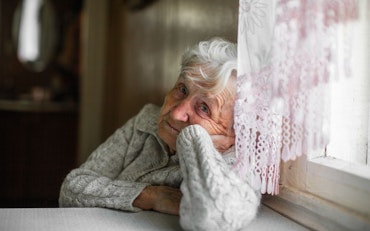COVID restrictions are changing again, so what are the latest rules?
Last week, the National Cabinet unanimously agreed to scrap the mandatory COVID-19 isolation requirements, except for those working in aged care – foreshadowing the beginning of relaxed COVID-19 rules.
![<p>If you are living in a nursing home, there are some things you can do to protect yourself against COVID-19 and keep you and your fellow residents safe. [Source: iStock]</p>](https://agedcareguide-assets.imgix.net/news/articles/COVID-restrictions-are-changing-again-so-what-are-the-latest-rules.jpg?fm=pjpg&format=auto&w=550&q=65)
If you are living in a nursing home, there are some things you can do to protect yourself against COVID-19 and keep you and your fellow residents safe. [Source: iStock]
From October 14, people who test positive to the virus will no longer have to isolate.
While these decisions are not permanent and may be re-implemented in the event of a COVID-19 wave, there have been mixed views shared about the announcement from advocates and the wider aged care sector.
The Government has been upfront that COVID-19 is something we need to live with and should be treated like other infectious illnesses, like gastro or the flu.
Each State and Territory have begun rolling back COVID-19 requirements and each has their own protocol regarding COVID-19 and entering residential aged care facilities (RACF).
However, some aged care homes have put in place their own specific rules for entering.
So what are the rules and how might they impact you?
Living in a RACF in a “COVID-normal” time
If you are living in a nursing home, there are some things you can do to protect yourself against COVID-19 and keep you and your fellow residents safe.
Good hygiene, including washing your hands, can help stop the spread of the virus and other germs that may have been brought into your facility. You can learn more about protecting yourself in our article, ‘Keeping yourself healthy and safe during COVID-19‘.
You should ask your facility about their specific visitation rules, if there are any, to find out what restrictions are in place when you have someone visit.
You can remind your visitors to wash their hands and what rules they need to follow while visiting you, like wearing a mask.
If a COVID-19 outbreak occurs in your facility, there is a possibility that your provider may restrict access to outside visitors.
However, it is important to know how to stay in touch with your loved ones when they cannot visit. Make sure you have their contact details, like phone numbers or email addresses so you can stay connected.
You are also allowed to have one ‘essential visitor’ to come and see you once every day, including during a COVID-19 outbreak.
This is part of the Essential Visitor Policy that was adopted by the Government and your facility should allow one elected person to enter a day. It is likely that this essential visitor needs to be the same person every time.
What if you become unwell?
If you are not feeling well, you must report any symptoms, especially symptoms of COVID-19, to a care worker.
If you are displaying COVID-19 symptoms, you will be kept separate from other residents in your facility to attempt to reduce the spread between residents.
If you are sick, a care worker will assess you and may want you to be tested for COVID-19 as a precaution which will be provided by your facility.
Aged care workers will continue to support and care for you during any isolation period, but you will need to wear a mask.
If you need to leave your room for medical care or other reasons, aged care workers will provide you with a surgical mask and help you to put it on.
General visitation rules across the country
At any RACF in Australia, visitors should not enter any RACF if they have:
- Any COVID-19 symptoms
- Have received a positive Rapid Antigen Test (RAT) or Polymerase Chain Reaction (PCR) test in the past seven to ten days
- Are awaiting the result of a PCR test
- Are a close contact
Also, anyone over the age of 12 needs to wear a mask when visiting a RACF and visits should not be held in any inside communal areas.
Visitation should occur in a resident’s room or in an outside area.
Keep in mind that your aged care facility may have different rules in place for visitors to the home. It is important to discuss these rules and regulations with your provider, as well as let them know of any specifications you have for receiving visitors.
Additionally, vaccination requirements differ between States and Territories, it is ideal to check with your State/Territory Health Department websites about these requirements.
Visiting a RACF in Queensland
In Queensland, you must comply with requirements the facility has in place regarding protective personal equipment (PPE), like masks and other protective measures.
Depending on the situation, a COVID-positive visitor may be able to enter a RACF with an exemption.
These include for end-of-life visits and compassionate circumstances.
Visiting a RACF in New South Wales
Visitors need to produce a negative RAT on the same day that they attend the facility.
Visitors may remove their mask while communicating with another person who is deaf or hard of hearing, but they should then maintain 1.5m distance from others where possible.
COVID-positive visitors who are coming to the facility for compassionate reasons may be assessed by the facility to determine whether it is safe to visit.
Visitors are strongly encouraged to be vaccinated for COVID-19 and to receive their booster doses when they are due.
Visiting a RACF in Australian Capital Territory (ACT)
People who are in days six and seven after a positive test must not visit a RACF in the ACT, unless they have prior approval from the facility.
Aged care facility visitors will be asked a set of screening questions on entry which may change depending on the State’s COVID-19 situation at the time of entry.
If a visitor answers yes to any of the screening questions, they may not be able to enter.
Visitors are strongly recommended to have the yearly influenza (flu) vaccine, but do not stipulate any mandated vaccination status to enter.
Visiting a RACF in Victoria
Currently in Victorian RACFs, there are no limits on visitor numbers.
But all visitors to RACFs must have a negative result from a RAT taken on the same day they want to visit.
All visitors must declare in writing at the start of their visit that they:
- Are free of COVID-19 symptoms (other than symptoms caused by a health condition or medication)
- Are not currently required to self-isolate, self-quarantine or a close contact
- Have received a negative result from a COVID-19 rapid antigen test on the same day that they attend the care facility
Visitors may be exempt from entry requirements for an end-of-life visit or if they are providing urgent support for a resident’s immediate physical, cognitive or emotional wellbeing.
A RACF may require vaccination for COVID-19 and the flu to enter the facility.
Visiting a RACF in Tasmania
In Tasmania, visits to RACF are allowed but individual sites and facilities may have their own processes and procedures surrounding entry requirements.
An exemption for close contacts and COVID-positive cases to visit a RACF may be provided by the Director of Public Health for compassionate reasons like the rest of the country.
A RACF may require vaccination for COVID-19 and the flu to enter the facility.
Visiting a RACF in South Australia
Visitors to a South Australian RACF are no longer required to be vaccinated against influenza or COVID-19.
COVID Safe Plans and COVID-Safe check-ins are also no longer required at a RACF.
All visitors and staff are also no longer required to undertake temperature checks to enter a RACF.
Visiting a RACF in Western Australia
Showing proof of vaccination is still required by Western Australian RACFs.
Individual RACFs can also determine the number of visitors permitted per resident each day.
You cannot enter a RACF without having had an up to date flu vaccine.
Visiting a RACF in the Northern Territory
There are no limits to the number of visitors per resident in an aged care facility at any one time.
What are your thoughts on the current changes to COVID-19 rules? Tell us in the comment below.










